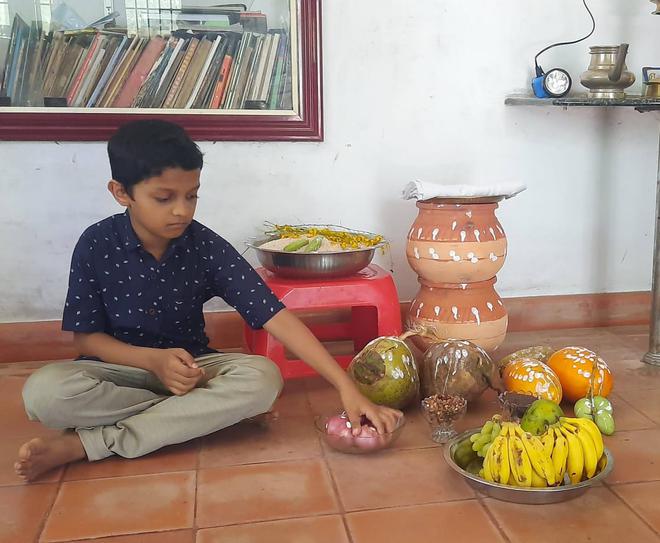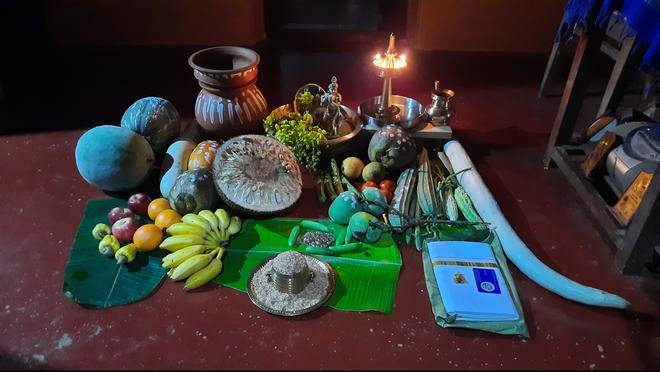Vishu is the day when you wake up to see all things auspicious or the Vishukkani.
But the resplendent kani (the first thing one sees), which is believed to usher in a year of happiness and prosperity, differs from region to region, even from house to house. “Thanks to umpteen ‘How to arrange Vishukkani’ videos on social media, I am often confused about the components,” says Arundhati S, an entrepreneur from Thiruvananthapuram. She adds, “I have never kept some of those elements in the kani that my mother traditionally arranges at home.”
The staples of a Vishukkani are the uruli (traditional cookware in bronze), nilavilakku (traditional lamp), kanikkonna (golden shower), kanivellari (golden cucumber), mangoes, jackfruit, rice, coins, mirrors, gold and silver ornaments and a new or freshly-laundered mundu or dhoti, all arranged before the Krishna idol. In some households any sacred text, kanmashi (kohl), vermillion and ashtamangalyam (a set of eight auspicious objects) are also kept.
Vipina E, who moved to Thiruvananthapuram from her home town, Kozhikode, eight years ago post-marriage, says, “I was surprised to see so many fruits — apples, grapes, pineapple and what not. Our kani mostly has home-grown produce such as mangoes, jackfruit and bananas. Also, neyyappam (a fried sweet snack made of rice flour, jaggery and ghee) is a must for our kani, whereas there is no such practice in Thiruvananthapuram.”

Vijaya Bhaskar, a Thiruvananthapuram native, adds, “When I was young, we had just the kanivellari, mango, jackfruit and cashewnut among the produce. But now it has become a norm to keep all the fruits.” Vijaya says that she does not place kanmashi (kajal) or kumkum (vermillion), which have become common.
In Central Travancore and parts of North Kerala, it is common to see wick lamps inside coconuts broken into two halves. The wick, which is made using clean cloth is filled with rice, says K Rekha, writer. However, in some places coconut halves are placed without the wick. “In our home, one half of the coconut is filled with kalluppu (rock salt) and the other with puliyavara (butter beans),” says Manjula Jyothiprakash from Alathur in Palakkad.
Rekha adds that some devotees pleat the kasavu mundu like a hand fan; it is kept in a kindi, with the vaalkkannadi inserted in it. “I remember how our dhobi used to bring home clean, starched dhotis with those pleats. The kanivellari which is kept in the uruli is ‘dressed up’ with gold ornaments. A kindi filled with water and a clean towel are also placed. Wet your eyes with the water and dry with the towel before watching the kani,” explains Geetha Menon from Ernakulam.
Each element in the kani has a significance, says Rekha. “Jackfruit is for Lord Ganapathy and mango for Lord Subramanian. The uruli stands for the universe, kanikkonna is the crown of the kalpurush or personification of time, with the lamp forming the eyes, holy book his words and vaalkkannadi his mind,” she says, adding that the festival is celebrated with more fervour in parts of north Kerala. “Since we are supposed to place home-grown produce, you might even find rose apple and bread fruit in the kani in certain homes,” Rekha says.
Ammu Pillai L, a lawyer from Cherthala in nearby Alappuzha district, says that they keep a piece of jackfruit instead of the full fruit. “Drumstick is usually included in our kani. Then we have the ashtamangalyam, which includes a coin, vaalkkannadi, clean dhothi, dashapushpam (10 sacred flowers), a sacred text, a lamp, kanmashi, vermillion, and sandalwood paste. We don’t keep any tubers,” says Ammu.
The components of the ashtamangalyam are slightly different at Hema Harindranath’s home in Kozhikode. Instead of dashapushpam, the arrangement has tulsi (basil) leaves or chethi (ixora), besides a piece of turmeric and black bangles. Unniyappam (sweet, fried dumplings) is a must in the kani, she adds. However, Priyamvada Menon, another Kozhikode native, points out that no cooked items are included in the kani. “Necessary components of our kani are kanikkonna, kanivellari, kasavu mundu, valkkannadi, gold and silver jewellery, any sacred text, kanmashi, kumkum and vilakku. We place kovakka (ivy gourd) along with mangoes and jackfruit,” Priyamvada says.
If you think the kani is incomplete without a Krishna idol and uruli, that is not the case everywhere. Suresh Ezhuvanthala, a teacher and folklore exponent from Cherpulassery in Palakkad, says, “While all elements are arranged inside the uruli, we don’t place the idol. It is the harvest that is significant, not the deity.”

The kani in some parts of Kannur district does not have the idol or the uruli. Instead, you will see new clay pots called kanikalam, which are decorated with rice paste/flour. “We usually place three pots; one has unniyappam, the second one rice and a third one has adakka chunanga, a round fried snack made of rice, wheat flour and jaggery. The elements of kani include freshly harvested rice, ornaments, coin, and panchangal or any five varieties of pulses —vanpayar, kadala, uzhunnu, thuvara parippu, cherupayar or muthira — mustard, onions, a bunch of raw mangoes, a pair of unhusked coconut, kanikkonna, kanivellari, kovakka, bananas etc,” says Savithri P from Kannur.

Vishukkani in Kasaragod district also has the kanikalam. “We keep only one pot, filled with rice. We also place unniyappam and undalikkam, (small deep fried rice balls), on banana leaves and kovakka. Some people place have started placing Krishna idols and uruli as well these days,” says Sreevidya M, a native of Kolathur in Kasaragod.
However, irrespective of the variations, it is important that the significance of Vishukkani is not lost.







